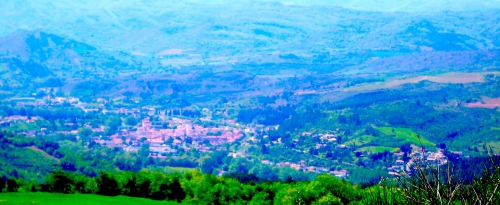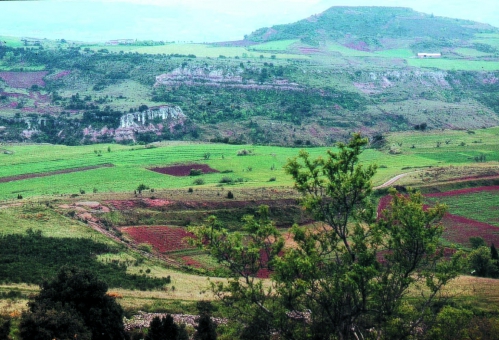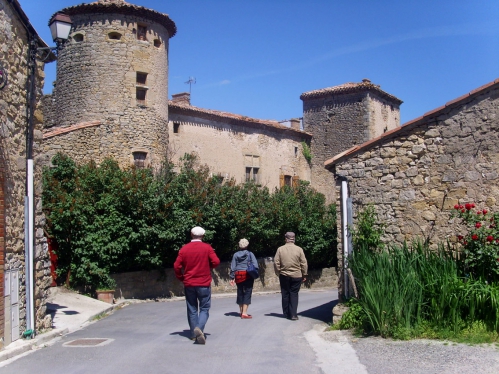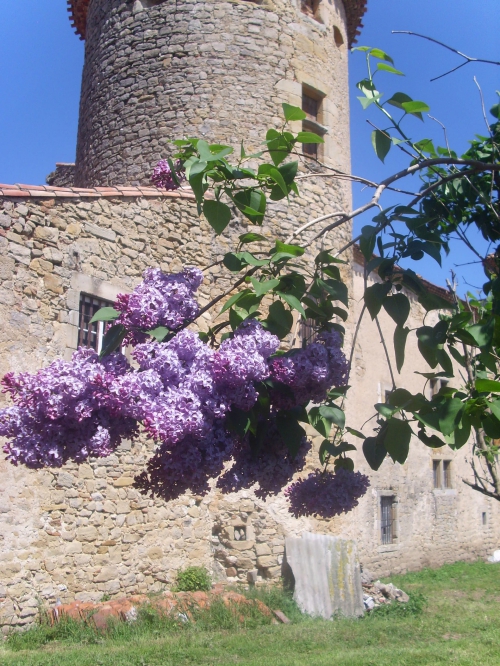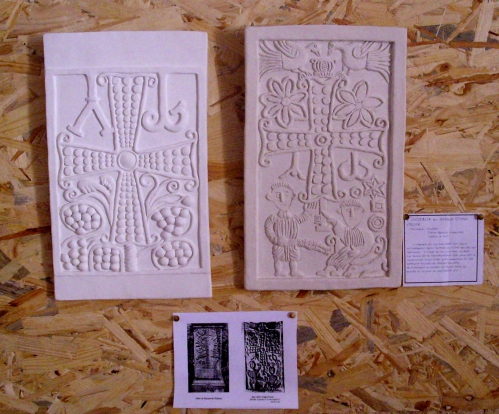Rennes-le-Château village
(Scroll down to see everything.)
CONTENTS
Introduction
The History of Rennes-le-Château
Brief word on the legends!
Contacts and Links
Rennes-le-Chateau
You can find the village, in the western Corbieres, by taking the D118 south from Carcassonne and continuing through Limoux and then Alet-les-Bains to arrive at Couiza. As you leave Couiza, (driving slowly!) look for a tiny road on the left with an even tinier sign also on the left, saying Rennes-le-Chateau. This narrow winding road, with wonderful views, takes you into the hilltop village.
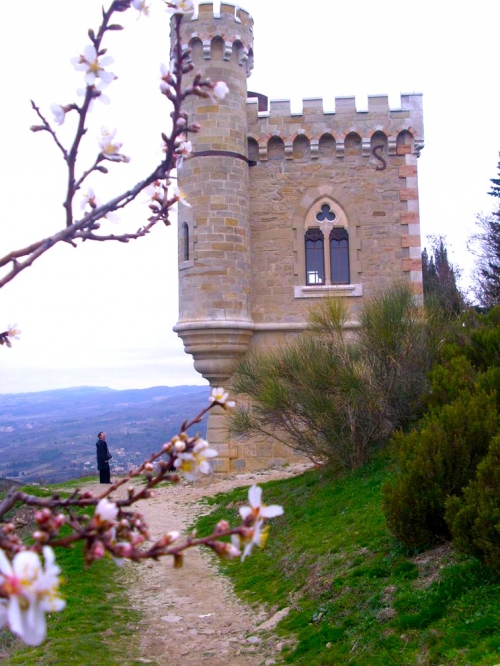 The Tour Magdala in springtime
The Tour Magdala in springtime
In high summer one parks in the parking provided, but at other times you can drive right through the village to the carpark by the water tower with its fantastic views to the south. The Tour Magdala (above), which has become so symbolic of Rennes-le-Château, can be seen to the right.
To the south-east, the village of Esperaza; to the south-west, what once was the lower town, the the gorge where now runs the Couleurs river, and the Las Casteillas, where the Celts used to live in pre-Christian times. The ninth-century lower town (below) has never been excavated.
In this view from outside the village, from the south-east, you can see the citadel of Rennes on the right, and the sloping area of land on the left. At one time the citadel, and the lower town, comprised an medieval town bigger than the Cite of Carcassonne is today. The lower town stretched from the citadel to the tower that you can just see on the left of the photo.
But maybe you now want to explore the village! leave the carpark and you will see the restaurant, le Jardin de Marie, on the left (see more here) and then Porte de Rennes, the famous book and gift-shop.
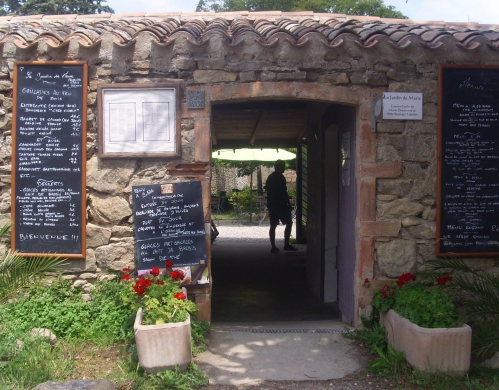
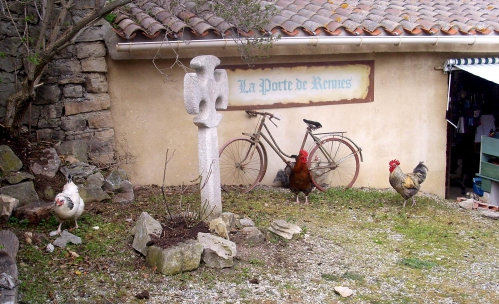
Then you can turn right into the church garden, then through the arch to the office of tourism. There you can buy an entrance ticket to the museum, the Villa Bethania that Bérenger Saunière built for Marie Denarnaud, the garden with their raised walkway to view the valley, with the Tour Magdala at the end of it. (There will be a separate article for the church.) The château that gave the village it's name? It is on the left as you walk down the hill, beside the Dragon restaurant and opposite the Atelier Empreinte bookshop. It is privately owned so you cannot enter, but is still very picturesque.
The history of Rennes-le-Château
Rennes-le-Chateau was founded in 414AD by the Visigoths and it was called by them "Rhedae" after the covered wagons that they parked in a circle where are now the ramparts.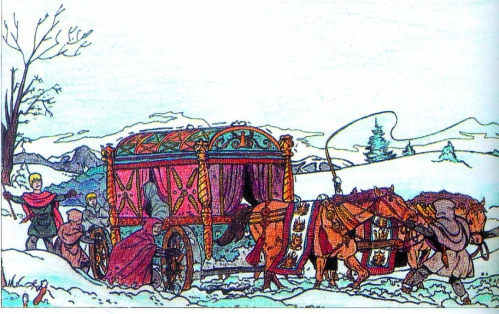
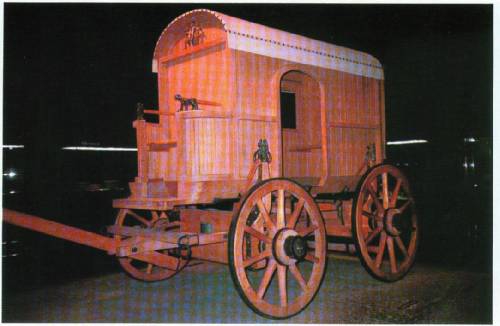
It was Roman, but the Visigoths were quite Romanised, and the richer people decorated their wagons. The second picture shows a "rheda" retored by archeologists.
In early medieval times Rhedae was the capital of the area ruled by the Visigoths, approximately the same as today's Languedoc region. I feel I have proved this by comparing the Visigothic altar pillar found in Rennes-le-Château with the Visigothic stèle in Narbonne.
These two plaques were made for me by by sculptress friend Annie Jal from Narbonne, one representing the altar pillar, the other the Narbonne stèle. In their early days the visigoths did not use figures in their art and sculpture. And so the Rennes-le-Château sculpture is older than the Narbonne one. The Visigoths were in Rennes in 414 AD, in Narbonne 462AD. Below is the Knights' Stone, both the original and a rubbing of it - this stone was Carolingian, that is, in the second half of the 8th century.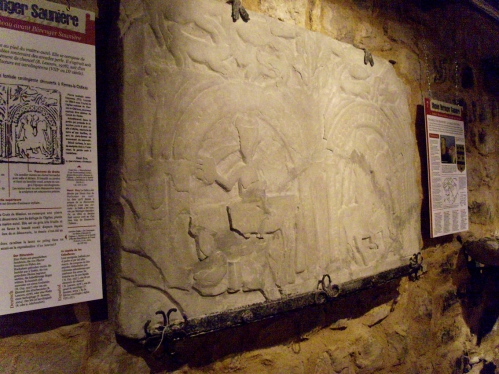
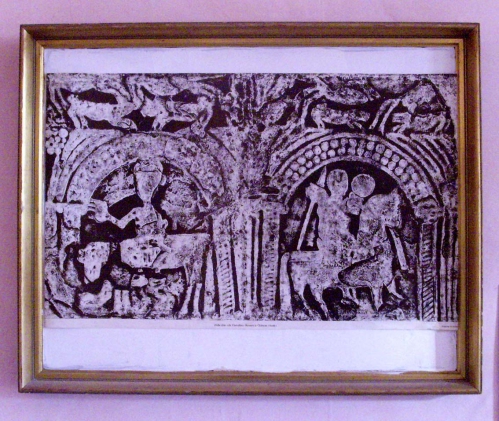
The Knight's Stone. At one time you could buy "rubbings" - I got one and framed it.
In the 14th century, due to battles and wars between comparatively small kingdoms; Toulouse, Barcelona, Carcassonne, Beziers, etc, the village and castle was taken by the Spanish in 1362. They left only the chateau, the church of Sainte Marie Madeleine and a handful of houses, and the village was named Rennes-le-Chateau.
I recently tried to sort all my photos of RleC (I have visited many times over the last 30 years) and it seemed that not only the museum was always in a different place, but any museum at the time always had different things in it from the museum before!
I can remember going into a bedroom in the Villa Bethania; it was set up as a scene of Bérenger Saunière's bedroom. These things are popular in French museums - everything in the room is supposed to be as it was when the person lived in it. Except that Bérenger Saunière never lived in the Villa Bethania. He always slept in the presbytère, the room, in fact, on the right as you go into the door of today's museum.
None-the-less, this scene in the bedroom brought a tear to my eye, I don't know why exactly. I remember thinking; "Why can't they let him rest in peace?"
Later I found out why he had called it Villa Bethania. I was researching early Christianity and found a document dated 1910. In this document the House in Bethany, the home of Mary Magdalene, Martha and Lazarus, was called the House in Bethania. It was the normal name for "Bethany" at that time, Bérenger Saunière wanted his house to be reminiscent of the house in Bethany that Jesus had visited so often. At the time the Church did not believe that Mary of Bethany was the same person as Mary Magdalene, but it seems Bérenger had worked out that she was.
At the time of these visits I didn't know how important to my life Rennes-le-Château was going to become so I never took notes. But I remember the museum being in a sort of curved corridor. On another occasion it seemed to me that something I wanted to see, that I'd seen before, was missing; but meanwhile dinosaur's eggs had appeared, which I didn't really think was much to do with our dear priest.
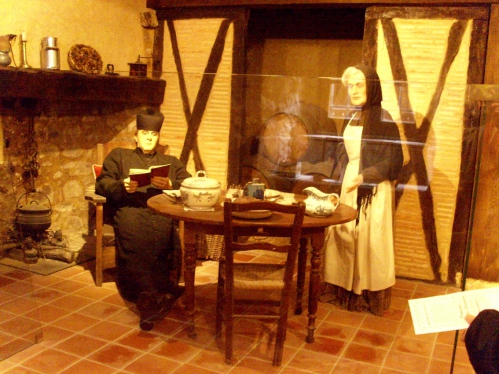
The first thing you see, entering the museum, is this "mis-en-scène" of Bérenger being served his dinner. In the early days it was not Marie Denarnaud that cooked his dinner, but Alexandrine, Marie's mother, (as shown here) in the lodgings she provided for him until the presbytère was renovated. But this scene is in the very room that used to be the kitchen of the presbytère, where it WAS Marie who cooked for her dear priest.
So, researcher's hat on, I delved into the history of the Rennes-le-Château museum.
In the late 1980's Henri Buthion owned the domain of Bérenger Saunière - the villa, the park with its belvedere walkway, the Tour Magdala and the garden with its pool in front of the villa - which he ran as a hotel. The presbytère was leased to him by the Mairie. Henri Buthion's finest hour was when he stared in a film about Rennes-le-Château, playing the role of the priest. The film was an enormous success and 50,000 visitors came to the village that year.
It was decided that something should be done to accommodate and attract them better, and so the Association Terre Rhedae was born, run by volunteers. The commune decided not to renew the lease on the presbytère to Buthion and so they rented the presbytère to Association Terre Rhedae. The first museum opened the following year, based on the abbé's inheritance in the hands of Claire Corbu and Antoine Captier. Claire is the daughter of Noel Corbu who bought the villa from Marie Denanaud.
After the success of The Holy Blood and the Holy Grail, a major work about the mysteries published in England, the number of visitors to the museum in the presbytère increased rapidly, and so did the facilities. Antoine Captier shared anecdotes about the priest with the customers; his grandfather was the bell ringer who was there when Bérenger found something in the wooden pillar from the Renaissance altar rail. His wife Claire came on Sundays. Marcel, his younger brother, with his nephew Michel, worked on a strip cartoon telling the legend - you can still buy it in the Porte de Rennes. Celia, Marcel's English wife, explained everything to the English visitors. It all became quite lively.
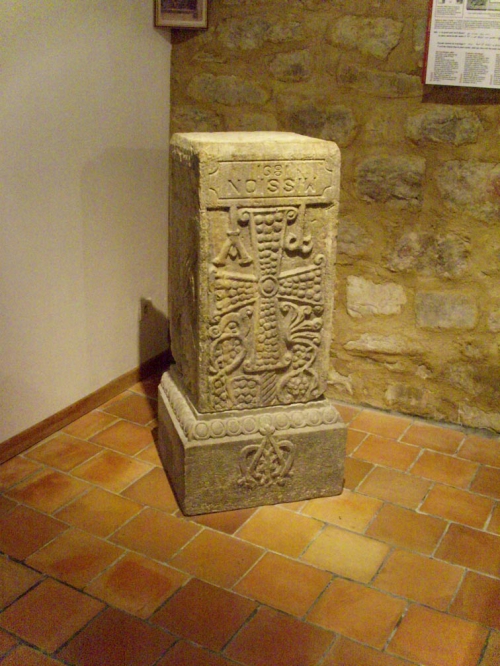
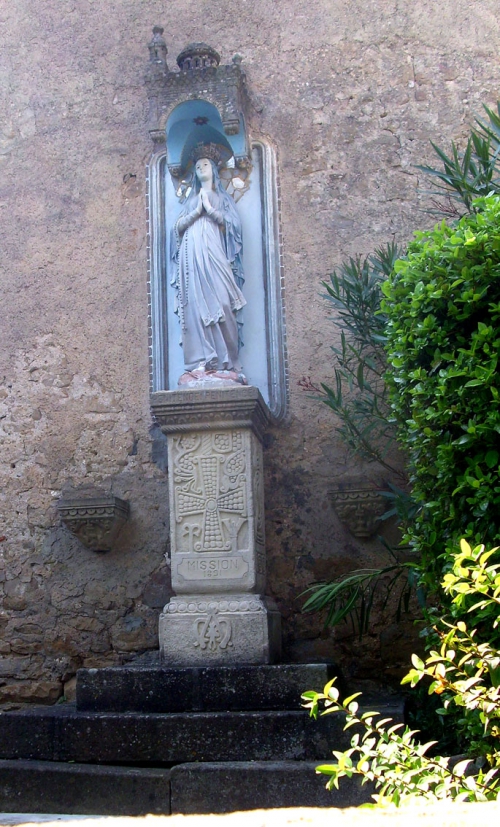
The original Visigothic altar support in the museum; it's "twin" had never been found. Some say the Visigothic pillar at Rennes-les-Bains was its twin, but the design is not at all the same. Besides, sometimes the alter slab was supported by only one pillar. The pillar under our Lady of Lourdes in the church garden is a copy, but upside-down as Bérenger placed it.
In Autumn 1992, during a week of lovely fine weather, the Marie decided to repair the roof of the presbytère roof. Scaffolding was erected and old tiles taken off. A tarpaulin had been put in place for the weekend, just in case of rain. Unfortunately a storm blew up, it rained heavily, and there was a flash-flood in Rennes-les-Bains. The presbytère of Rennes-le-Château was completely flooded.
The items in the museum were rescued because now the whole building would have to be renovated. The work was done but during it many things disappeared. Nothing remains of any original decor from the time of Bérenger, nor the stonework of the original door into the church, which was blocked when the presbytère was built in the eighteenth century, (a plaque on the wall says 1727) leaning against the church, and a new church door was made, where is now the church porch.
If the building was a museum, you would think they would have left visible the stonework of this door, in the room on the right as you go in, the room that was once Bérenger's bedroom.
In 1994 Jean-Luc Robin, a restauranteur, came to Rennes-le-Château to run the domain on behalf of Dutch/American owners. In 1997 a trench was dug across the park to link a new kitchen to the drains. Two metres down (that's quite deep, deeper than the tallest man, deeper than the statuary depth for sewerage pipes) the trench cut across remains of some very old walling, and between these two walls were found "some skeletons", pottery fragments dating from the 3rd century BC to the 3rd century AD, an Iberian coin and a fragment of Greek vase of some archeological interest.
To Jean Luc this confirmed the village had been an important Iberian oppidum. He put these pieces in a glass display case. An archeologist friend identified them and made proper labels before they were put on display. Another friend, a regular diner at his restaurant, gave Jean-Luc some Roman tokens he had found near Narbonne while working on the vines. Care was taken no-one thought these were found at RleC.
I am a bit sceptical about this story from Jean-Luc Robin's book. The Romans had settled at Rennes-les-Bains, not Rennes-le-Château, and the oppidum is in today's commune of Rennes-le-Château but was not where is the citadel village today. Jean-Luc Robin also tells us that the bits and pieces he found were "commandeered" by the Mairie, after they were wrongly identified as valuable. I'm not sure.
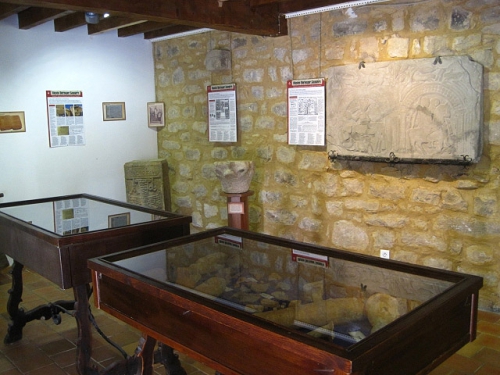
The museum as it is today. Noe the Knight's Stone on the wall.
Meanwhile, Jean-Luc Robin had become friendly with Claire Corbu and Antoine Captier.
Antoine Captier and Claire agreed to transfer the abbé's heritage, various belongings of Saunière's, letters, documents, furniture, personal effects, into the villa, where they would act as guides. When her father left Rennes-le-Château in 1967 he had taken all BS's papers with him, so Claire and her husband had a complete collection, which they left in the hands of Jean Luc. A little later it was decided to convert what had been Noël Corbu's restaurant under the belvedere into a museum; the tables were still there and could be converted to display cabinets. The view was superb. (You can see the windows that Buthion had dynamited out by walking along the new footpath around the ramparts.)
Exhibits included the wooden pillar, the priest's clothes with a monogram ( it was very fin-de siècle to initial everything, houses, gates, and so on, which is why the BS on the baptismal font represents BS's initials.) Then there were his beautifully embroidered priestly vestments. His personal possessions - a pen, a prayer-book, a walking stick, a complete set of the picture postcards he had published, plus lots of papers, including Marie's will naming Noel Corbu as her heir. It looked good. Antoine had told the Terre de Rhedae museum that he would be leaving them within the month and would be needing his things for a new museum. The Association promptly photocopied everything. So in the two museums in the village, one showed reproductions, the other showed the genuine articles.
Jean-Luc became friends with Henry Lincoln, who was doing tours to RleC at the time and so a TV was set up running Henry Lincoln's English films. Jean-Luc refurbished the Tour Magdala to represent Bérenger Saunière's library, filling the shelves with old-looking volumes, as cheaply as possible. Meanwhile, the tower had to be repaired, made watertight, and an Occitan flag posted on the turret. (I can remember visiting the Tour Magdala and being so disappointed that the books in it, many published after Bérenger died, were never Bérenger's. Marie Denarnaud had been obliged to sell his books in her poverty days. I just wanted to hold the books that Bérenger had held, and think about what his interests were.)
Jean-Luc renovated the two ground floors rooms of the Villa into a salon and dining-room, furnished with genuine pieces, some of which had belonged to Bérenger, and renovated the chapel Bérenger had built when they appointed another priest over him.
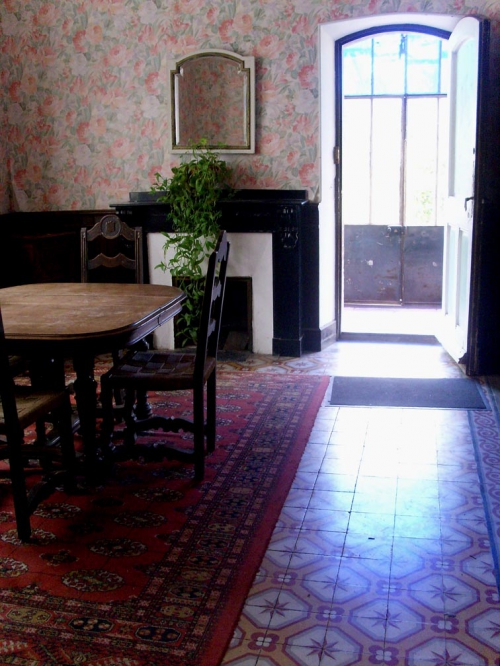
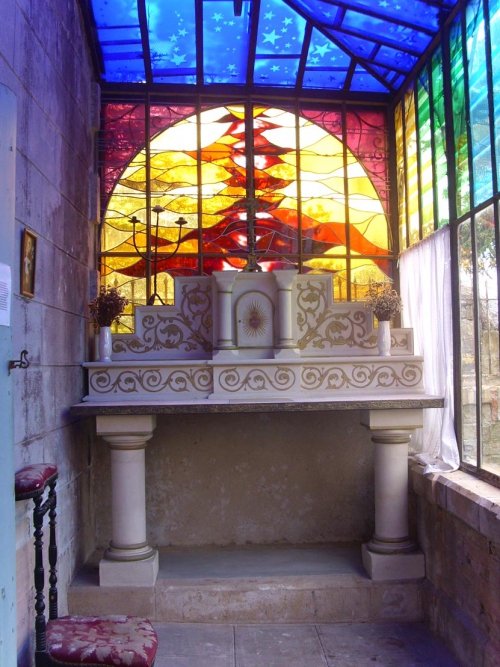
The dining-room in the Villa Bethania opens into the chapel
The museum and the visits to the domain were all a great success.
But - rivalry was established with the Terre de Rhedae. Then the bickering and in-fighting that started to depress him, he wrote. He offered his landlords the chance to sell the domain. Jean-Luc Robin had to leave. In spite of tight filming schedules, his friend Henry Lincoln kept him company right up to the last minute before his departure.
However, Rennes-le-Château pulls us all back - Jean-Luc returned in 2001 and re-opened La Table de l'Abbé in the garden facing the Villa Bethania.
My own museum visits
I was at Rennes-le-Château in the summer of 2000 but didn't go into the museum. The lady in the tourist office came to lock up the church and dusk was falling. She kindly waited a moment to allow me to photograph the devil holding up the font and told me she was English and lived a little way down the hill "to get away from all the politics." She also said the commune was going to buy the domain, which they did, before the end of the year.
Today the museum is firmly bedded into the presbytère and run by the Mairie. It's well done and interesting, and there's often new things that weren't there before. I was intrigued by a facsimile of Marie d'Ables tombstone - and a notice about a tombstone for a two year-old boy, her son. With him the Hautpoul line died out, only a daughter followed, who married into the Fleury family of Rennes-les-Bains. (The daughter had several names, confusing many who decided she had had several children who squabbled over her money, which she left to Abbé Bigou instead. Not true.) When Marie Marie d'Ables died she left the château to her daughter and some personal wealth to her parish priest, Antoine Bigou, who left it all behind when he fled the Revolution.
One has to pass through the Tourist office to get to the museum. The small entrance charge includes the museum, the Villa Bethania, the chapel, the park with Bérenger Saunière's grave, the belvedere with it's wonderful views and the Tour Magdala. The church, now a listed monument, is open all day, no charge, but the cemetary is closed.
And the museum is STILL changing!
During my visit in September 2011, I found that the facsimile of Marie de Négre d'Ables tombstone had disappeared, and a new beautifully executed marble stone had appeared in its place, looking nothing like the original one.
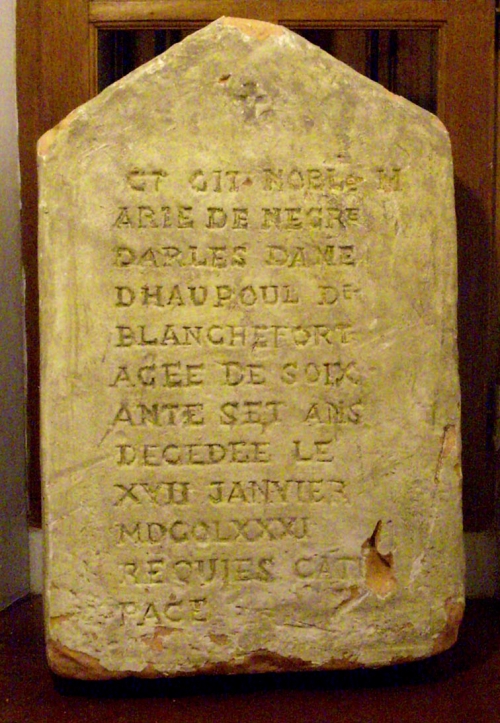
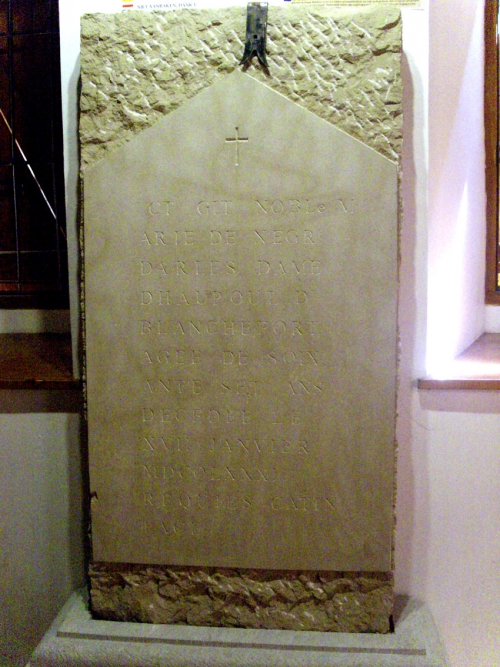
The legends of RleC insist that Berenger Sauniere himself destroyed this tombstone because the secret coded message on it would "destroy the Church." But that is not true. A treasure hunter smashed the tombstone a short time before 1990, for a photograph exists of the pieces, long since disappeared, in the ossuary in the graveyard.
And a drawing exists made by SESA - Société d'Etudes Scientifiques de l'Aude - who visited in 1905 and published the drawing in 1906. They drew it because they were amused at the lack of skill of the mason; whoever carved obviously did so from something in Latin written on a sheet of paper that the mason couldn't read or understand - don't forget, this all happened before the Revolution, in the late 18th century, when many people could not read or write. (Rennes researchers don't believe this can happen, but I once went to a funeral in England to find the family in tears because the mason had spelled the family name wrongly on the tombstone.) It looks to me as though this second version of the tombstone is taken from the SESA drawing.
Perhaps the most intriguing find of Rennes-le-Chateau is the so-called Celtic Altar, a huge slab of sandstone which used to be in front of the Mairie.
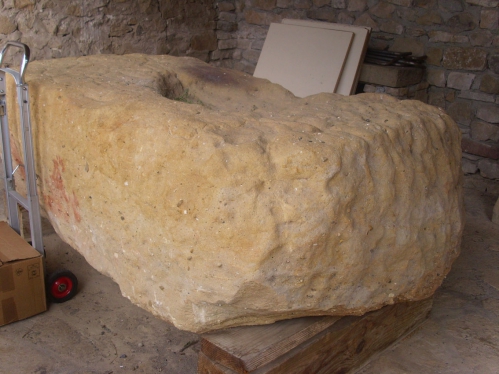
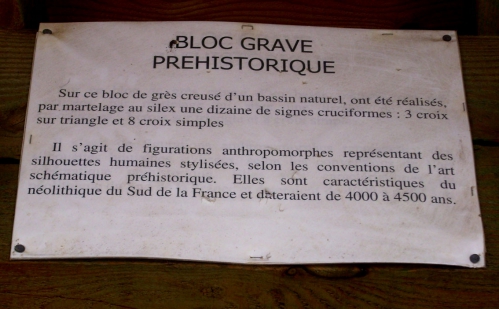
The notice above tells us that it is 4000 years old and carved with several cruciform crosses - nothing to do with Christianity, but thought to be simple representations of human beings, typically neolithic in the south of France and dated 40000 to 45000 years old, that is, about 25000BC.
On top of the slab is an indentation which led to the story that the stone was an altar on which live sacrifices were performed. Then another legend arose; because it was found near the cave called Mary Magdalene's cave, and the stone had crosses on, it was something to do with Mary Magdalene. But the cave was only named that around 1980 by the psychic lady who lived nearby; the local people still call it the Grotte de Fournet, meaning little oven. (Click here for more info.) Always with Rennes-le-Chateau, one mystery leads on to another . . . .
This stone has recently been moved to a place where more people will be able to see it, just in front of the Tour Magdala.
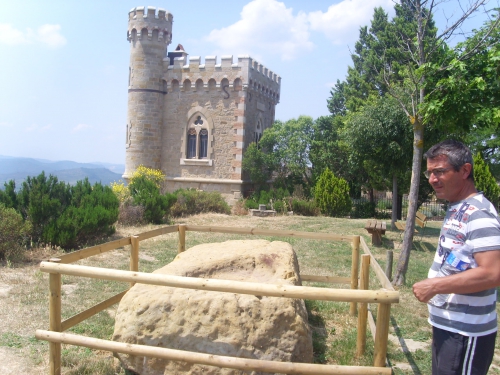
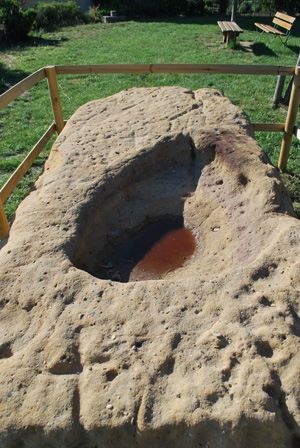
It seems to be a rather rough sandstone; I'm amazed the crosses have lasted so long . . .
The Legends grew wings . . .
In 1885 the priest Berenger Sauniere was posted to Rennes-le-Chateau and started to renovate the church there, dedicated to Mary Magdalene. He found, among other things, Visigothic graves in the crypt. He became very rich, constructing a new house with gardens and a tower. Nobody knows where the money came from . . . but some of us have a pretty good idea.
Many people who visit Rennes-le-Château are on a Quest for the Secret or the Mystery, which involves great wealth. The Treasure!
At Rennes-le-Château, we're told, clues have been left by the priest that only the most brilliant person can solve. He who passes all the tests, who moves successfully from one clue to another, will find the treasure. This story is so powerful that people return to it, time and time again, almost against their own will. It's basically a Holy Grail legend. Grails are often connected with mountaintops.
I too am fascinated. In my early days of seeking a solution to the Rennes-le-Chateau mystery, I decided the treasure was not wealth, but a secret. I had no desire for great wealth - but oh a secret! that was some else, truly spiritually worthwhile. (It may interest you to know that Bérenger Saunière also had similar beliefs.)
Do people honestly believe they can follow clues and find a treasure huge in its world-shattering importance? Some people think the "discovery" of a bloodline of Mary Magdalene and Jesus proves the Church was lying all the time, and that the Vatican will give people money to keep quiet, because if the story gets out, that the Church is built on a lie, then people will stop believing.
No treasure has ever been found at Rennes-le-Château just as one never comes to the end of a Grail quest. The atmosphere there is buzzing as people compare their discoveries, both physical, emotional and spiritual. It would be dreadful if anyone ever found anything and the mystery was solved! But the place is truly magic . . . .
The First Day Of Summer - and a cure?
In May 2010 my friends, Jean and Marie-Noel, kindly took me to Rennes. We arrived just after noon, so lunch was the first thing on the menu. We left their little dog, Cabriole, in the car, because she was fragile after being ill for some time, but the kind atmosphere in Le Jardin de Marie, and the kindness of the staff, meant Cabriole could come with us and sit under the table waiting for titbits.
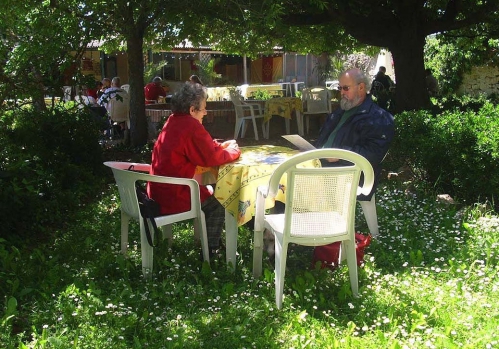
The four of us enjoyed smoked Salmon, a beef stew in the Camargue style (cooked in red wine and very tender), tarte au citron, wine and coffee. We were able to look up at the face of the Villa Bethania - and the face of Jesus - as we ate.
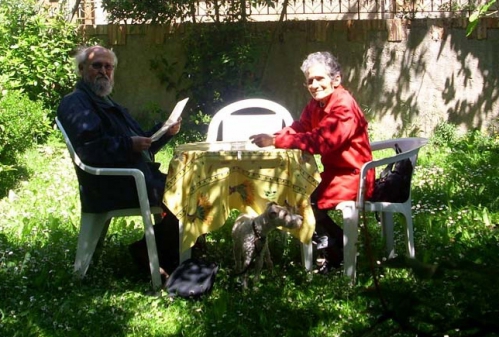
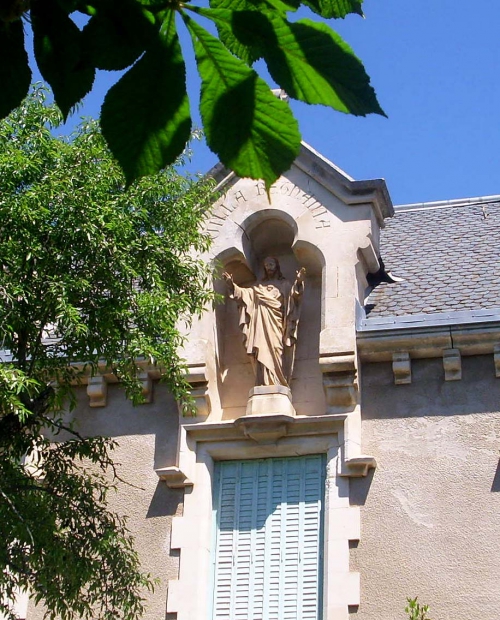
A couple of days after we got home, the little dog started to get better and within a week was completely back to normal. "It's as though she has been resurrected," said her owner Jean. "Really - like a miracle." A coincidence? Or had the "vibes" of Rennes, Jesus and Berenger Sauniere conspired to cure a little dog? Certainly, Berenger and his companion Marie, loved animals, Bérenger always asked after them in his letters when he was away from home.
Contacts and Links
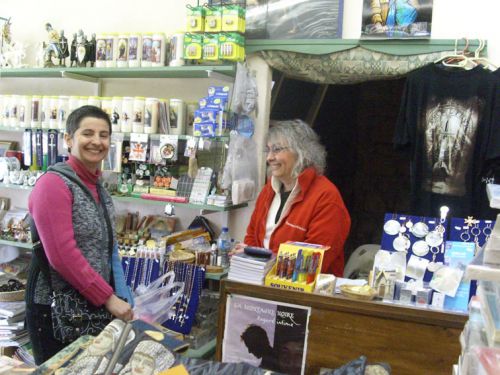
Helene the owner with happy customer
La Porte de Rennes, souvenirs and gifts. Just in front of the church. Specialises in books in English. Tel 04 68 74 30 17. See more here. For those outside the region they have their own site, mostly in French but go to "BOOKS" to see books in English. www.rennes-le-chateau.tv
Le Jardin de Marie, bar/restaurant, Rennes-le-Chateau Open Easter to November
tel 04 68 20 99 71 Meals and snacks available all day. See more here.
Les Labadous, just to the south of Rennes, offers studios, a lovely restaurant in peaceful surroundings, beautiful gardens and an unique atmosphere suiting this mystic area. 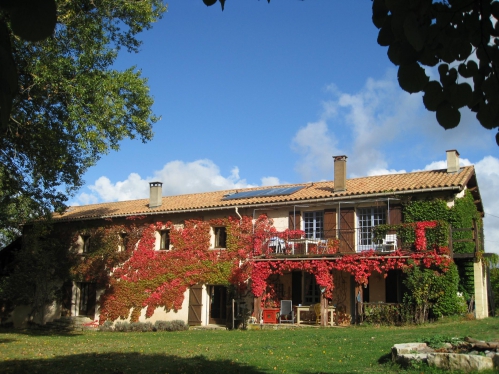
The owner has found much "energy" that manifests itself as circles of light on photos, invisible before the photos are taken. These are called "Orbs."
Now in 2013 he has written a book about Orbs. Click here for further details.
Librairie Atelier Empreinte.
Serious bookshop, with books in English and other languages as well as French. A second-hand department, with some titles now out of print, offers much to the dedicated researcher. Grande rue, 11190 Rennes-le-Chateau, tel 04 68 74 26 71 More info here. Their web-site offers books in English to those outside our region; http://www.atelier-empreinte.fr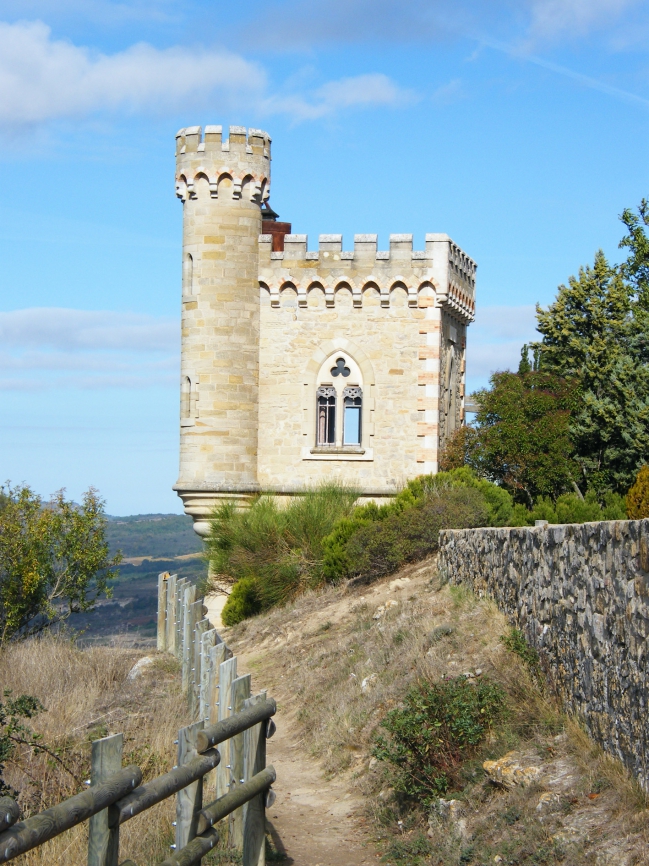
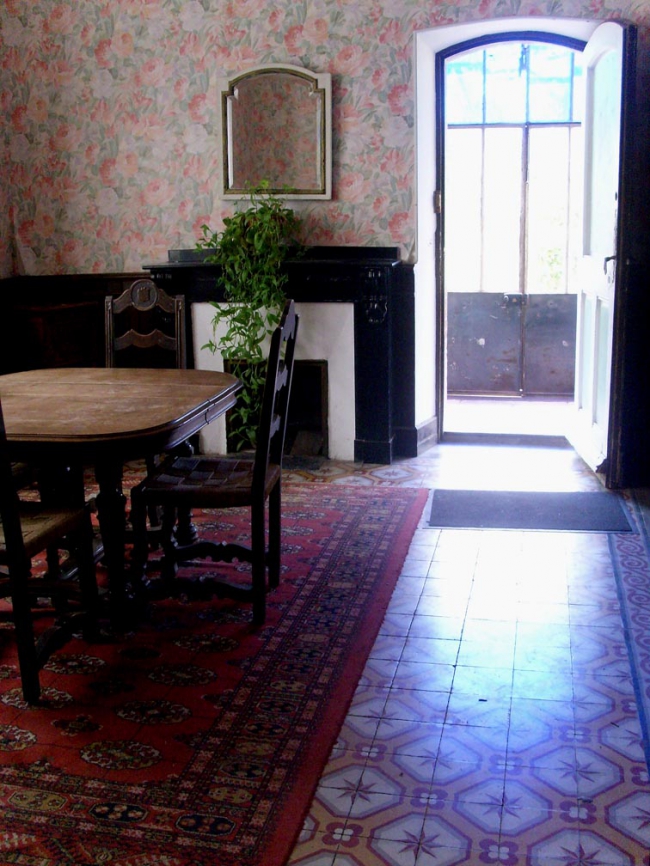

favourite images of Rennes-le-Château
Inscrivez-vous au blog
Soyez prévenu par email des prochaines mises à jour
Rejoignez les 96 autres membres

